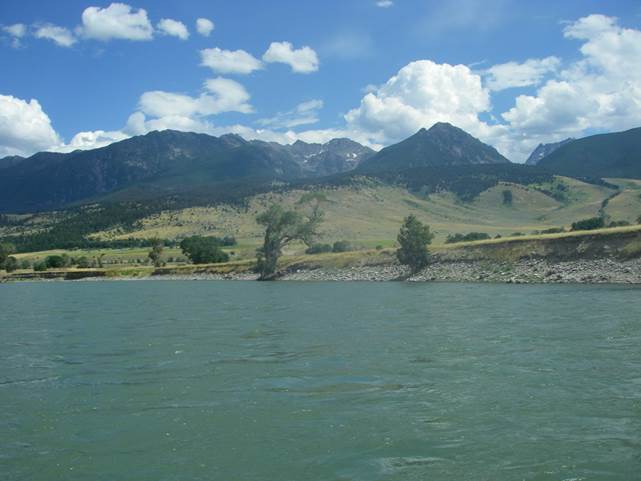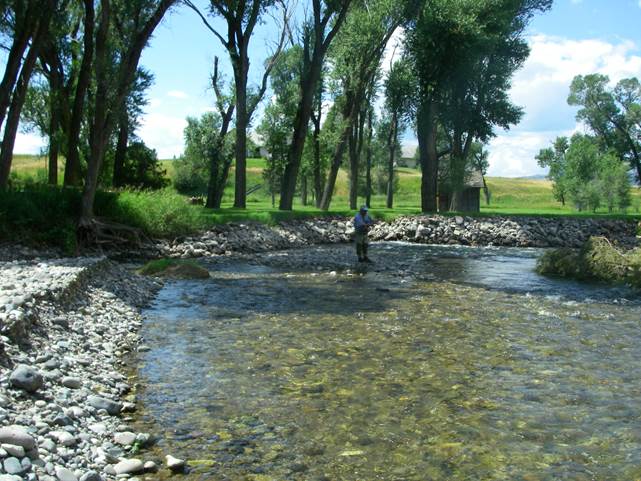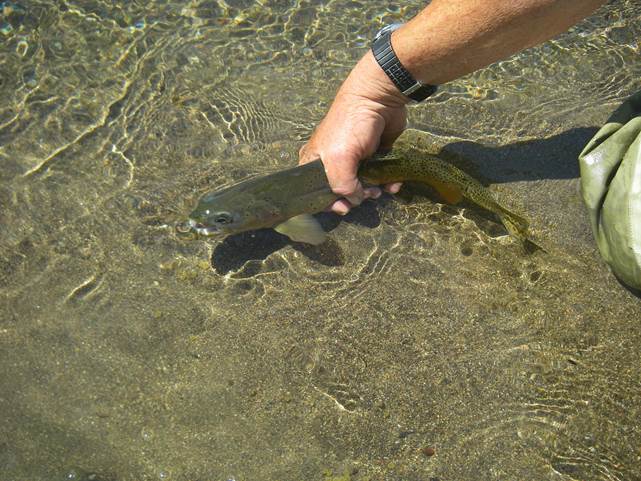EVENINGS ALONG THE STREAM (part 24)
| Sysadmin Note |
|---|
| Part twentythree can be found here |
July 28, 2011, the Yellowstone River continued to drop as the tributaries dropped and cleared, however the Yellowstone River would not become fishable until the river dropped enough so that it was no longer washing the walls of the Grand Canyon of the Yellowstone. On July 23rd the flow on the Yellowstone dropped to 12,500 CFS, however the gauge at the outflow of Yellowstone Lake was still 8,150 and believe me that is high for that time of year as the normal flow would be 5,510 CFS on the river and 3,380 CFS at Lake. As the river falls the changes in the islands, back channels, riffles, run and pools will become more evident, and from a safety point of view the river should be less than 9,000 CFS for safe floating and anything over that involves greater risks than you would experience when the flows were lower.
Some streams, like the Big Horn, can safely be floated at 9,000 CFS or higher. However, the gradient of the Yellowstone is different than the Big Horn. The Yellowstone is very fast and things can happen quickly, and if you are attempting to float when the visibly of the water is questionable, then you are just flat stupid or you have a death wish. With reduced water visibility you risk hitting a submerged tree that is hung up on the bottom of the river or slamming into a log or huge rock that the river has placed but are not yet visible to the naked eye. Already there is rafting traffic on the river and soon the guides and anglers will be on the river, I fear before it is really fishable and safe.
My friends, the Yellowstone River is a major river of tremendous size and speed and if you lose your respect for the river it can kill you, and we lost some people this year. Don't let that happen to you. If you are using a guide and you are unsure of the conditions, simply check to USGS stream flows on the Internet and it will give you the current flow and what is normal. Furthermore if the river is not at least greenish with 30 inches of visibility I would question how it will fish and what tactics will be needed.
In 2011 many of the guides and the fly shops were so starved for business that they sent people on the river when the river was unsafe or the fishing was marginal at best. With my anglers I always have plan B; the spring creeks, one of the local ponds, or one of the other area rivers that is clear enough and is running at safe flows. I asked one guide how the fishing was with the high, dirty water and he said, "Ok, we are getting six to eight trout per day." I asked if that was per angler and he replied, "No, per boat." That my friend is not good fishing for the Yellowstone River, yet by July 30th many guides were out on the river.
On August 6th, I visited Yellowstone National Park and found that the Gardiner River, Lamar River, Slough Creek and Soda Butte Creek were still all high but safely fishable. I took Tucker and Jackie Nelson with me as they want to learn the waters of the Park and the rivers and creeks of the Northeast section of the park is good place to start. Tucker is the son of Roger Nelson the owner of Nelson's Spring Creek, and with his wife Jackie they make a first-class husband and wife guide team. They both want to learn as much a possible about fly fishing and guiding fly anglers and I am more than happy to share my knowledge with them. They are both are good fly anglers and love to fish. They are at the top of their class of younger guides.
During the summer of 2011 the hatch charts were worthless. We found Golden Stones, Gray Drakes, PMD's and Green Drake along with a couple of species of Caddis all hatching at the same time, and many of these hatches were 30 days behind a normal year. We stopped at numerous sections on the various rivers and I explained my approach and what I look for at certain times of the year, and we finally ended up on Soda Butte Creek and fished during the afternoon and evening and enjoyed excellent fishing.

August 10th Neil and I floated the Yellowstone River from Gray Owl to Mallard's Rest, and while the flows were safe enough the river was still high for this time of year. It was still gray and chalky colored. Neil took two reasonable trout on dry flies. We tried nymph combinations and nymph and streamer combinations along with various dry fly and wet combinations and the results were six trout from the Yellowstone River itself along with a few whitefish.

However, I had chosen this section to float because Mill Creek enters the Yellowstone River in this section and Mill Creek is one of the top small stream fisheries in the Paradise Valley and it was clear. We stopped at the mouth of Mill Creek and spent a couple of hours fishing up the lower end of the creek and took several rainbows and cutthroat trout, this stop alone made for a great fishing day.

It is my opinion that anglers travel to the waters of Montana to fish for wild trout in the clear sparkling waters that have been touted in books and magazine articles for more than a hundred years. In my opinion gray chalky water lacks the power to excite me when discussing the Yellowstone River. Yes I have fished in the gray chalky water of glacier fled rivers in Alaska and had great success when fishing for various species of salmon on their spawning runs to compare that to the waters of the Yellowstone with similar colored water is totally different under these conditions the river just does not fish well and with many other options to choose from there is no need to spend a day on water that will fail to inspire you. Normally by August 10th during a normal year we would be hard into some good hopper fishing, but this year the hoppers along the river were about a size 14 at this time and it would be late August or early September before they reached a reasonable size. That doesn't mean that the fishing will be spotty but anglers will have to be more observant. The hatch charts and habits of the fish that you might see during a normal year are useless during a season of uncharted waters.
As the river drops and clears the guides and anglers alike will have to relearn the river and the riffles, runs, flats, side channels and island, since they have all change under prolonged high water periods. Thus once again the anglers are challenged by the mysteries of uncharted waters.
All of these changes, though often dreaded by anglers, are in fact the very essence of fly fishing since no two days or two years are the same. There is always something to learn and adventures to experience.
Enjoy & Good Fishin'
| Editor's Note |
|---|
| 2011 was an unusual year in many places in the Rocky Mountain West. The heavy snow pack and the late spring combined to keep many of the major rivers virtually unfishable until well into August. Even after the rivers finally dropped and cleared they remained unseasonably high well into the fall. 2012 was the exact opposite of 2011 with very little snow and low flows during the summer season. What challenges 2013 will bring for anglers remains yet to be experienced. |
